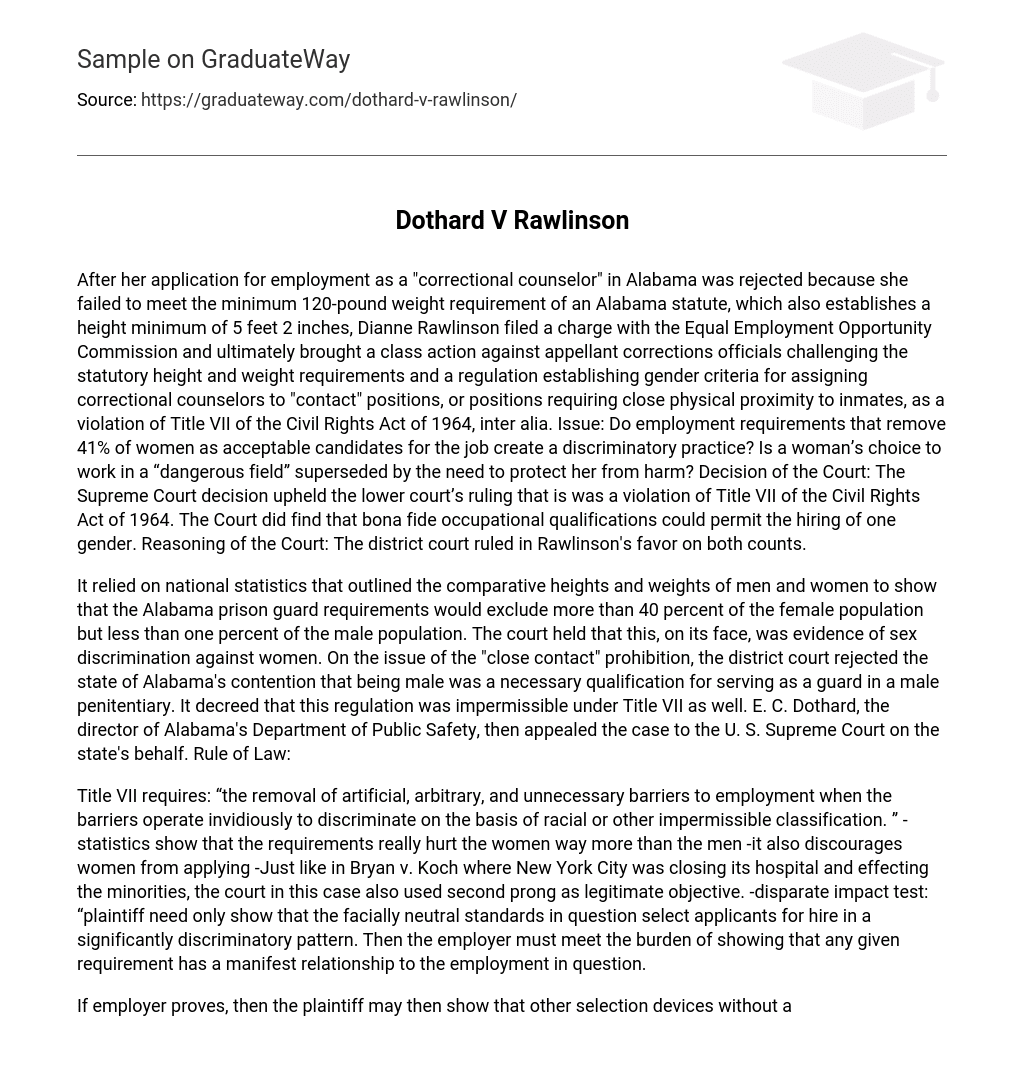Dianne Rawlinson sought employment as a “correctional counselor” in Alabama but was denied due to not meeting the minimum weight requirement of 120 pounds and minimum height requirement of 5 feet 2 inches, as outlined by an Alabama statute. She then appealed to the Equal Employment Opportunity Commission and initiated a class action lawsuit against corrections officials, contending that these requirements, along with a regulation specifying gender criteria for assigning correctional counselors to “contact” positions, violated Title VII of the Civil Rights Act of 1964. The key question was whether these employment standards, which disqualified 41% of women, amounted to discrimination and if a woman’s decision to work in a hazardous field could be disregarded for her own safety. The Supreme Court affirmed the lower court’s ruling that these requirements did indeed contravene Title VII but acknowledged that legitimate qualifications relevant to the job could justify hiring only one gender. Previously, the district court had ruled in favor of Rawlinson on both matters.
According to the analysis of national statistics, more than 40% of women would not meet the criteria for being Alabama prison guards. In contrast, less than 1% of men would be affected. This discrepancy is seen as evidence of gender bias. Additionally, the district court rejected Alabama’s assertion that only males could work as guards in male prisons, stating it violated Title VII. E.C. Dothard, director of Alabama’s Department of Public Safety, appealed to the U.S. Supreme Court on behalf of the state.
Under Title VII, there is a requirement to eliminate employment barriers that result in discrimination based on impermissible classifications like race. However, statistical evidence indicates that these requirements disproportionally affect women and discourage their participation in the workforce. This can also be observed in the case of Bryan v. Koch, where the closure of New York City’s hospital had a similar impact on minorities and the court considered it a valid objective under the second prong. By utilizing the disparate impact test, it suggests that a plaintiff only needs to demonstrate that neutral standards unfairly benefit certain applicants. Consequently, it becomes the employer’s responsibility to establish a clear connection between specific requirements and the job at hand.
If the employer can demonstrate a discriminatory effect, the plaintiff can argue that alternative selection methods that do not have the same discriminatory effect can still serve the employer’s legitimate interests in efficient and trustworthy workmanship. The court additionally concluded that the exclusion of women from high security prisons is job-related as it helps protect them from sexual assault. Justice White dissented, stating that Rawlinson failed to prove a discriminatory hiring pattern based on height and weight requirements, as she relied on statistics about the general population rather than the specific pool of applicants for prison guard positions in Alabama.
Rawlinson’s lack of meeting the weight requirement and absence of legal grounds to sue over the provision regarding “close contact” was emphasized by his viewpoint. However, Justices Marshall and Brennan dissented, concurring with the Court on the height and weight prerequisite but differing on the aspect of “close contact.” They contended that there was no evidence substantiating the belief that female prison guards faced higher risks of assault compared to male guards. Furthermore, they maintained that using violent behavior among prisoners as a basis for denying job opportunities to female applicants should not be justified.





